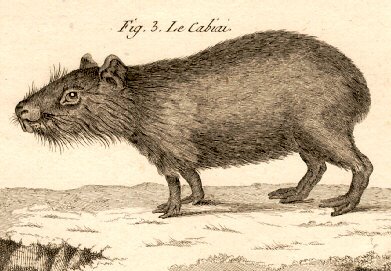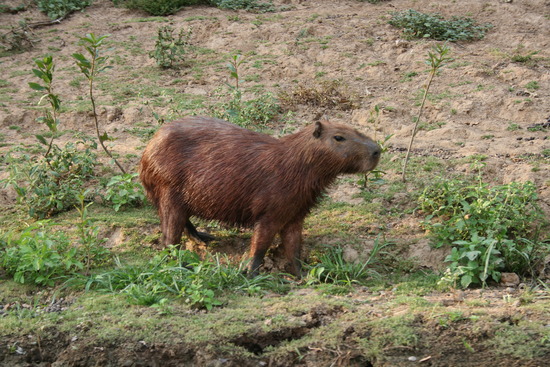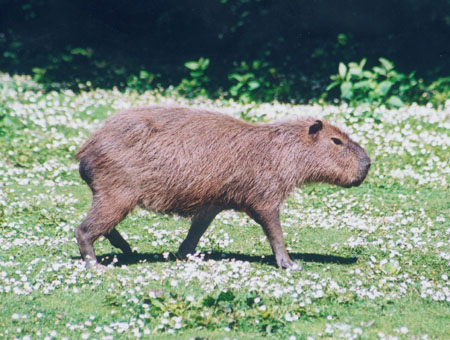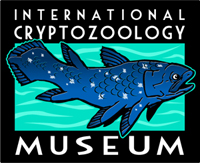Actor Sees Capybara Near London
Posted by: Loren Coleman on October 2nd, 2009

When first seen, people would draw these animals as if they were a large rat. In some ways they were correct, and in others they missed the subtle personality of this new species.

Photography has clarified the smoother lines of this beast and its rather unbelievable size.
The world’s largest living rodent is the capybara (Hydrochaeris hydrochaeris) of South America, which grows to 4.5 feet.

Sometimes they do turn out in unusual places.
As Wikipedia notes: “Many escapees from captivity can also be found in similar watery habitats around the world. Though it has been erroneously stated that a population of capybara existed in the River Arno in Florence, Italy, this was determined to be the nutria or copyu, (Myocastor coypus) a considerably smaller South American aquatic rodent with a similar appearance.”
How many accounts have you come across of out-of-place capybaras in your corner of the world? Isn’t there a population roaming the hills in northern California near a Marine base, as I recall?
Here are some other sample locations where capybaras, which are native to South America, have been seen recently in out-of-place spots:
December 1995. An adult capybara was viewed feeding on the banks of a canal near the Santa Fe River, near Lulu in Union County, Florida.
December 1995. An adult capybara was shot on the banks of the Suwannee River in Gilchrist County, Florida.
Summer 1999. An adult capybara was seen by a kayaker on the upper Santa Fe River, Florida.
December 1998. The remains of three juvenile capybara were found along Milhopper Road, near Gainesville, just west of the Devil’s Millhopper, Florida.
June 2001. An adult capybara was found dead – hit by car – on SR 72, just east of the Myakka River Bridge, Florida.
July 2001. A capybara was seen near Reading, Berkshire, England, but experts decided it was probably a misidentification until the later sightings.
January 2002. These sightings in Upton-on-Severn in Worcestershire, UK, convinced the authorities to change their minds about their earlier skepticism. (See listing, here.)
2004. A capybara was photographed in the Ozark Mountains, Missouri.

Credit: Pueo.
July 2006. Just south of Eyemouth, a large animal around two foot tall, identified as a capybara, was seen sitting on its haunches in the middle of the A1, Berwickshire, England.
August 2006. Various sightings of an allegedly escaped capybara were reported from around Lunenburg, Massachusetts.
March 2007. Six to eight capybara were sighted feeding in the grass near I-75 and the Santa Fe River, Florida.
January 2008. “Residents of Grantville, Georgia, reported a large hairy animal roaming around which turned out to be a loose capybara. DNR refused to catch it, so the town got tips from a zoo and caught it themselves. It has now been sent to an out-of-state zoo that agreed to take it.” Source.
February 2009. A single huge reddish-brown capybara was reported on two occasions near the Cherry Hill Orchards property, Lancaster County, Pennsylvania.
June 2009. A capybara was sighted in Berwickshire as it ran across the A1 at the cross roads near Reston, England.
And now comes word out of England of the celebrity sighting of one of these animals:
The largest living rodent in the world was spotted scampering across farmland in Totteridge last week.
Hollywood actor David Dayan Fisher, 42, saw the 140-pound, 3ft-long capybara while walking in fields near Darlands Lake on September 20 [2009].
The barrel-shaped rodent is not native to English countryside, but is normally found in densely forested areas of South America.
It looks similar to a giant guinea pig, with slightly webbed feet, no tail and a blunt muzzle.
Mr Fisher sighted the creature while walking with his seven-year-old nephew and nine-year-old niece, Louie and Pebbles Fisher.
He said: “We were out walking the dogs and were going through a wooded area very close to the lake, when suddenly Pebbles saw what she thought was a baby cow.
“I looked over and thought it was a deer, but then my nephew suddenly shouted: ‘That’s what crocodiles eat!’
“I realised he was right, though I had no idea what it was called until we Googled it later.
“It was very distinctive, with a squat body and flat head and a very unusual hop. It seemed to be worried as it was running to the cover of the corn fields as quickly as possible.”
Mr Fisher, who has appeared in Charmed, 24 and Stargate Atlantis, and starred in National Treasure with Nicholas Cage, said he was “blown away” by the discovery.
“I’ve seen quite a lot in my life, but to see this in the Totteridge area was something else.
“I couldn’t believe my eyes. It wasn’t meant to be here. It was something foreign. I felt like an intrepid explorer discovering something really special.”
Source: The Times
I need a capybara to stop by the museum. The donations are dropping and the set-up is not complete. Help!! Where are the $15 and $25 donators?
Assist the International Cryptozoology Museum as it opens in downtown Portland, Maine. Please click on the button below (not the one up top) to take you to PayPal to send in your museum donation.
If you wish to send in your donation via the mails, by way of an international money order or, for the USA, via a check (made out to “International Cryptozoology Museum”) or money order, please use this snail mail address:
Loren Coleman, Director
International Cryptozoology Museum
PO Box 360
Portland, ME 04112
Come visit the museum at 661 Congress Street, Portland, Maine 04101, beginning November 1, 2009!!
Thank you!
About Loren Coleman
Loren Coleman is one of the world’s leading cryptozoologists, some say “the” leading living cryptozoologist. Certainly, he is acknowledged as the current living American researcher and writer who has most popularized cryptozoology in the late 20th and early 21st centuries.
Starting his fieldwork and investigations in 1960, after traveling and trekking extensively in pursuit of cryptozoological mysteries, Coleman began writing to share his experiences in 1969. An honorary member of Ivan T. Sanderson’s Society for the Investigation of the Unexplained in the 1970s, Coleman has been bestowed with similar honorary memberships of the North Idaho College Cryptozoology Club in 1983, and in subsequent years, that of the British Columbia Scientific Cryptozoology Club, CryptoSafari International, and other international organizations. He was also a Life Member and Benefactor of the International Society of Cryptozoology (now-defunct).
Loren Coleman’s daily blog, as a member of the Cryptomundo Team, served as an ongoing avenue of communication for the ever-growing body of cryptozoo news from 2005 through 2013. He returned as an infrequent contributor beginning Halloween week of 2015.
Coleman is the founder in 2003, and current director of the International Cryptozoology Museum in Portland, Maine.













I was also wondering if it wasn’t just a mistaken sighting of a Nutria. According to this, Nutria were introduced to England prior to 1944 but in 1988 it was claimed that all the wild Nutria had been trapped. It’s possible they were wrong.
I envy Mr. Fisher.
And kudos to his nephew for being knowledgeable about such things.
Could be Nutria, but Fisher seems certain it is a Capybara. Who knows…
Just want to mention that I am a pet capybara, living in Texas. I have my own blog at GiantHamster.
It’s Boo, the miniature giant space hamster (from the Baldur’s Gate computer games).
No, seriously, in a bit of the synchronicity and coincidence and such with cryptozoology that Loren has written about in the past, it’s notable that the most recent English one is referred to as the Barnet Beast, and in the case near Cherry Hill Orchards in Lancaster, PA the witnesses were named Barnett.
About the Lancaster sighting: when first seen one of the first reactions of the witness was that it was a beaver. Strangely enough, Long Lane (where the sighting took place) becomes Beaver Valley Pike after it crosses Route 283. I fully intend to investigate the beaver angle at some point in the near future: several waterways are present in the area, and it’s possible one of those was home to a beaver — I, for one, hadn’t been aware that beavers ranged into Lancaster County, which they do, and I wonder if the witness did, and therefore if maybe her first instinct was correct.
In any case, I don’t think the Lancaster sighting was a capybara. The witness specifically mentioned a long tail which obviously capybara don’t have. Also similarly to this sighting, nutria was mentioned as a possibility in that case as well.
I’ve collected some sightings of capybaras in the US sent to me by readers of my (now infrequently updated) site about capybaras:
capybara sightings
I particularly recommend the newspaper story in the first link on that page.
Thanks for the info, Wombatarama. 🙂
In 2005 I saw one from above at about 10 metres distance moving along a small stream when I was quietly having a sandwich on Alderley Edge, Cheshire.